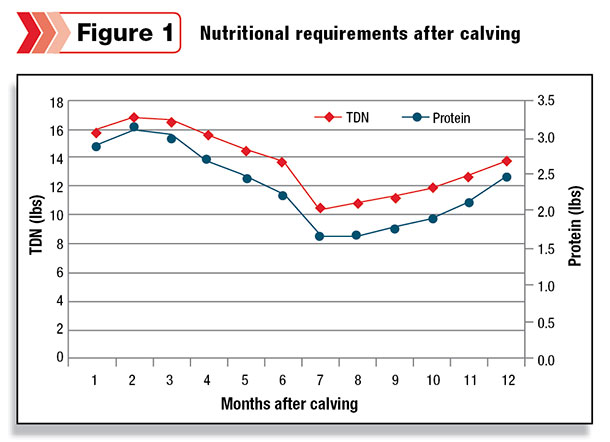But this article will focus on the cow herd because 85 percent of feed is used just to maintain the cow, an unproductive function. Developing a sound, forage-based nutritional program for the cow herd will help reduce feed costs.
Additionally, cow nutrition affects reproduction, health and expression of genetic potential. Thus, a sound nutritional program is important to a profitable cow herd.
There are six classes of nutrients: carbohydrates, lipids, protein, minerals, vitamins and water. Carbohydrates and lipids provide energy, which we measure as total digestible nutrients (TDN) in the diet of the cow and calf.
Protein provides nitrogen for rumen microbes to grow and digest forage and feed, and provides amino acids, which are the building blocks for proteins in the animal’s body.
Minerals and vitamins
There are over a dozen mineral elements important for proper function of the body. Minerals such as calcium and phosphorus are key parts of bone structure, while other minerals function as co-factors in metabolism. Vitamins have specialty functions in many systems of the body such as eyesight (vitamin A) and metabolism (B vitamins).
Water has an important role in metabolism and aids in body temperature regulation. Adequate consumption of all nutrients is important for optimum cattle performance.
Nutritional requirements change throughout the cow-calf production cycle. Nutrient requirements are greatest 60 to 90 days after calving and lowest after weaning the calf at 7 months old.
Then the cycle begins again, as nutrient requirements begin to increase as the cow moves into late gestation getting ready to deliver another calf, as shown for TDN and protein in Figure 1.
Energy factors
Energy measured as TDN is the most expensive nutrient for the cow herd – not because it has the greatest cost per unit of nutrient but because the cow requires TDN in much greater quantities than other nutrients. The lactating cow with average milk production requires 16 pounds of TDN per day but only 3 pounds of protein and 0.09 pound of calcium.
If we assume a cost per pound of $0.12 for TDN and $0.40 for protein, 16 pounds of TDN costs $1.92 per day while 3 pounds of protein is $1.20 per day. This example illustrates the importance of meeting the TDN requirements of the cow herd in the least expensive way in order to have the most cost-effective nutrition program possible.
Forage is almost always the least expensive source of TDN for the cow. Utilizing this feed source to meet nutrient requirements of the cow to the fullest extent possible is key for profitability.
One way to do this is to manage your breeding program so cows calve a week or two before spring pasture is available for grazing. This matches the time of greatest nutrient requirements of the cow with the time of greatest forage nutritive value.
Some producers have moved calving seasons ahead into late winter in order to have older, heavier calves at weaning in the fall. However, recent studies indicate greater feed costs for the cow herd between calving and spring pasture availability more than offset the increased income from the calves, resulting in less profit.
The grazing calendar
A second way to fully utilize forage in your nutrition program is grazing more days out of the year. In northern latitudes where pastures are predominantly cool-season perennial grass species, mid- to late summer is likely a time when forage production will be less than optimal.
In this situation, warm-season native grass species such as bluestems, indiangrass and switchgrass can be used to increase summer forage. Additionally, annual grasses such as pearl millets, sorghums and sorghum-sudan hybrids can be planted for summer pasture.
In southern latitudes, pastures are predominantly warm-season perennial grass species, resulting in reduced forage production during late fall, winter and early spring. In this situation, cool-season annual grasses such as wheat, oats and rye can be planted to increase forage during this time.
Another excellent option to extend the grazing season into late fall and winter is to stockpile perennial forages by fertilizing in late summer and removing cattle to allow forage to accumulate. This practice has been done successfully with bromegrass in northern latitudes, tall fescue in mid-latitudes and bermudagrass in southern latitudes.
Stockpiled forages provide inexpensive feed when forages are not actively growing and generally have adequate nutritive value to meet nutrient requirements of mid-gestation cows after weaning.
Rotational grazing
Rotational grazing systems can increase the nutritive value of available forage, which is another way to maximize the use of forage to meet cow nutrient requirements. In continuous grazing systems, some plants are not grazed, allowing them to advance to more mature stages of development.
More mature plants result in lower TDN available to the cow later in the grazing season when the cow is forced to consume those plants.
In a rotational grazing system, cows are moved through a system of small paddocks at a high stocking density, which means most plants are grazed before reaching reproductive stages. With less mature plants throughout more of the grazing season, rotational grazing supplies greater amounts of TDN later in the grazing season than continuous grazing.
Cows will be able to maintain greater body condition through late lactation in late summer and require less supplemental feed to regain lost body condition prior to calving.
Starting a new cattle business in any segment of the industry is a large undertaking with considerable financial risk. Developing a sound nutritional program based on forage will help reduce feed costs for any type of operation but is especially important for a cow herd.
Because forage resources vary considerably from one location to another, it is important to be knowledgeable about the forages in your operation.
Resources to assist in preparing a nutritional program specific to your area are provided by the state cooperative extension service. Contact your local cooperative extension office to speak with the beef cattle and forage specialists. ![]()

-
Phillip Lancaster
- Assistant Professor - Beef Cattle Production
- Darr School of Agriculture - Missouri State University
- Email Phillip Lancaster









